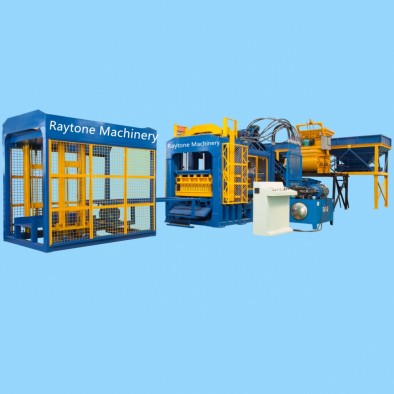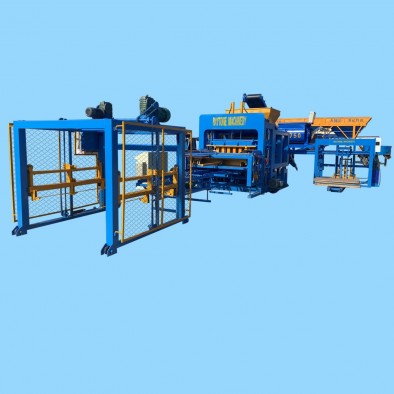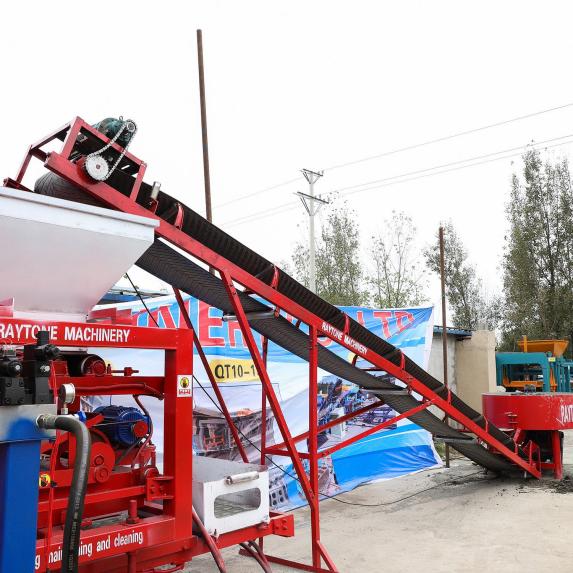- 28
- Feb
Can the block making machine be operated manually or does it require automation?
RAYTONE is a leading manufacturer and supplier of block making machines in the global market. Our company is dedicated to providing high-quality, efficient, and reliable block making solutions to meet the needs of our customers worldwide. As a company, we have over 20 years of experience in the block making industry. Our team of experts and engineers are committed to continuously researching and developing new technologies and designs to improve the performance and functionality of our block making machines.
We offer a wide range of block making machines, including manual, semi-automatic, and fully automatic machines. Our machines are suitable for various materials such as concrete, cement, fly ash, sand, and stone dust. They can produce different types of blocks, including hollow blocks, solid blocks, paving blocks, and interlocking blocks.
Our machines are designed with advanced technology and high-quality components that ensure durability, stability, and precision in the production process. They are also equipped with hydraulic systems that provide high pressure and efficient molding for consistent and uniform block production.

At our company, we understand the importance of productivity in any production process. That’s why we have developed a cutting-edge block machine that streamlines your production and optimizes your output. With advanced technology and precision engineering, our machine is able to efficiently and effectively produce high-quality blocks, saving you time and resources. Along with its speed and accuracy, our block machine also offers customizable features to meet your specific production needs. Trust us to maximize your productivity with our state-of-the-art block machine.
Craftsmanship and technology have often been viewed as opposing forces, with one valuing handiwork and the other prioritizing efficiency. However, in our block machine, we have found the perfect balance between the two. Our machine embodies the principles of traditional craftsmanship, utilizing precision engineering and expert manual labor, while also incorporating cutting-edge technology for enhanced productivity and quality control.

Block making machine, also known as brick making machine, is a device that produces concrete blocks or bricks in various shapes and sizes. It plays an important role in the construction industry by providing a cost-effective and efficient solution for producing building materials. With the advancement of technology and the increasing demand for sustainable building materials, block making machines have evolved to become more versatile and eco-friendly. In this article, we will delve deeper into the functionalities and benefits of block making machines and explore how they have revolutionized the way we build structures.
2.What is the process of transporting the blocks from the machine to the curing area?
3.Can a block making machine produce both hollow and solid blocks?
4.How does the block making machine control the density of the blocks?
5.Can a block making machine produce blocks with different surface textures?
6.What maintenance is required for a block making machine?
7.Can the block making machine be operated manually or does it require automation?
8.What is the expected lifespan of a block making machine?
9.How does the block making machine handle the release of excess water during the curing process?
10.What are the advantages of using a hydraulic block making machine?
1.Are there any special considerations when operating a block making machine in a high altitude location?
Yes, there are a few special considerations to keep in mind when operating a block making machine in a high altitude location:
1. Adjusting the mix design: At high altitudes, the air is thinner and contains less oxygen. This can affect the curing process of the concrete blocks, making them weaker and more prone to cracking. To compensate for this, the mix design of the concrete should be adjusted to include more cement and less water.
2. Longer curing time: Due to the lower air pressure at high altitudes, the curing time for concrete blocks will be longer. It is important to allow for this extra time to ensure that the blocks are fully cured and have reached their maximum strength.
3. Temperature fluctuations: High altitude locations often experience extreme temperature fluctuations, which can affect the curing process of the concrete blocks. It is important to protect the blocks from extreme heat or cold during the curing process to prevent cracking or other damage.
4. Adjusting machine settings: The lower air pressure at high altitudes can also affect the operation of the block making machine. It may be necessary to adjust the machine settings, such as the vibration frequency and pressure, to ensure that the blocks are properly compacted and formed.
5. Proper maintenance: It is important to regularly maintain the block making machine in a high altitude location to ensure that it is functioning properly. The thinner air and extreme temperature fluctuations can put extra strain on the machine, so it is important to keep it well lubricated and make any necessary repairs or adjustments.
6. Safety precautions: High altitude locations can also pose safety risks for workers operating the block making machine. It is important to take necessary precautions, such as providing proper ventilation and ensuring that workers are properly trained and equipped to work at high altitudes.
2.What is the process of transporting the blocks from the machine to the curing area?
1. Cutting and shaping: The first step in the process is cutting and shaping the blocks using a block making machine. The machine will produce blocks of the desired size and shape.
2. Loading onto pallets: Once the blocks are ready, they are loaded onto wooden or plastic pallets using a forklift or crane. The number of blocks per pallet will depend on their size and weight.
3. Securing the blocks: The blocks are then secured on the pallets using straps or bands to prevent them from shifting or falling during transportation.
4. Transporting to curing area: The loaded pallets are then transported to the curing area using a forklift or pallet jack. The curing area is usually a covered space with proper ventilation and temperature control to facilitate the curing process.
5. Stacking the pallets: In the curing area, the pallets are stacked on top of each other, leaving enough space between them for air circulation. This allows the blocks to cure evenly.
6. Curing process: The blocks are left to cure for a specific period, depending on the type of block and the curing method used. During this time, the blocks will gain strength and become ready for use.
7. Unloading and storage: Once the blocks have cured, the pallets are unloaded and the blocks are stored in a designated area. They are then ready to be transported to the construction site for use.
8. Reusing pallets: The pallets used for transporting the blocks can be reused for future batches, reducing waste and cost.
9. Cleaning and maintenance: It is important to regularly clean and maintain the block making machine and the curing area to ensure the quality of the blocks and the efficiency of the process.
3.Can a block making machine produce both hollow and solid blocks?
Yes, some block making machines have the capability to produce both hollow and solid blocks. These machines have interchangeable molds that can be easily switched out to produce different types of blocks. However, some machines may only be able to produce one type of block, so it is important to check the specifications of the machine before purchasing.
4.How does the block making machine control the density of the blocks?
The block making machine controls the density of the blocks by adjusting the amount of pressure applied during the compaction process. This is typically done through the use of hydraulic systems that can be adjusted to apply more or less pressure to the block molds. The machine also controls the amount of water and cement mixture used in each block, which can also affect the density. Additionally, the machine may have sensors or gauges that monitor the density of the blocks as they are being formed, allowing for adjustments to be made in real-time.
5.Can a block making machine produce blocks with different surface textures?
Yes, a block making machine can produce blocks with different surface textures. This can be achieved by using different molds or by adjusting the settings of the machine to create different surface textures. Some machines also have the capability to add surface textures during the production process, such as by using a roller or stamping mechanism.

6.What maintenance is required for a block making machine?
1. Regular Cleaning: The block making machine should be cleaned regularly to remove any dirt, debris, or residue that may accumulate during the production process. This will help to prevent any build-up that could affect the machine’s performance.
2. Lubrication: The moving parts of the machine, such as the bearings, chains, and gears, should be lubricated regularly to ensure smooth operation and prevent wear and tear. It is important to use the recommended lubricants for each specific part.
3. Inspection and Replacement of Worn Parts: The machine should be inspected regularly for any signs of wear and tear. Any worn or damaged parts should be replaced immediately to prevent further damage to the machine.
4. Calibration: The machine should be calibrated regularly to ensure that it is producing blocks of the correct size and shape. This will help to maintain the quality of the blocks and prevent any production issues.
5. Electrical and Mechanical Maintenance: The electrical and mechanical components of the machine should be checked regularly to ensure they are functioning properly. Any faulty components should be repaired or replaced immediately.
6. Training and Education: Proper training and education should be provided to the operators of the machine to ensure they are using it correctly and following all safety protocols. This will help to prevent any accidents or damage to the machine.
7. Storage: When the machine is not in use, it should be stored in a dry and clean environment to prevent rust and corrosion. It is also important to cover the machine to protect it from dust and other contaminants.
8. Regular Servicing: It is recommended to have the machine serviced by a professional at least once a year. This will help to identify any potential issues and ensure the machine is running at its optimal performance.
7.Can the block making machine be operated manually or does it require automation?
The block making machine can be operated manually, but it is more commonly operated with automation. Automation allows for faster and more efficient production, as well as reducing the physical labor required. However, some smaller or simpler block making machines may still be operated manually.
8.What is the expected lifespan of a block making machine?
The expected lifespan of a block making machine can vary depending on factors such as the quality of the machine, frequency of use, and maintenance. However, on average, a well-maintained block making machine can last for 10-15 years.
9.How does the block making machine handle the release of excess water during the curing process?
The block making machine does not handle the release of excess water during the curing process. This is typically done manually by the operator or through the use of a curing chamber or curing racks. The excess water is released by removing the blocks from the molds and allowing them to air dry or by placing them in a curing chamber where the temperature and humidity can be controlled to facilitate the curing process. Some block making machines may have built-in curing chambers or racks to aid in this process, but it is not a function of the machine itself.
10.What are the advantages of using a hydraulic block making machine?
1. High Production Capacity: Hydraulic block making machines have a high production capacity, which means they can produce a large number of blocks in a short period of time. This makes them ideal for large-scale projects.
2. Versatility: These machines can produce a variety of blocks, including hollow blocks, solid blocks, paving blocks, and more. This makes them suitable for a wide range of construction projects.
3. Consistency and Quality: Hydraulic block making machines use hydraulic pressure to compress the raw materials, resulting in consistent and high-quality blocks. This ensures that the blocks are strong and durable, making them suitable for use in construction.
4. Easy to Operate: These machines are designed to be user-friendly and easy to operate. They come with simple controls and require minimal training to operate, making them suitable for both skilled and unskilled workers.
5. Cost-effective: Hydraulic block making machines are cost-effective in the long run. They require minimal maintenance and have a longer lifespan compared to other types of block making machines. This makes them a cost-effective option for businesses.
6. Energy Efficient: These machines use hydraulic power, which is more energy-efficient compared to other types of block making machines. This helps to reduce energy costs and make the production process more environmentally friendly.
7. Customizable: Hydraulic block making machines can be customized to meet specific production requirements. This includes the size, shape, and design of the blocks, allowing for more flexibility in the production process.
8. Durability: These machines are built to withstand heavy use and harsh working conditions. They are made with high-quality materials and components, making them durable and long-lasting.
9. Reduced Labor Costs: With the use of a hydraulic block making machine, the need for manual labor is reduced, resulting in lower labor costs. This also helps to improve the overall efficiency of the production process.
10. Improved Safety: Hydraulic block making machines are designed with safety features to prevent accidents and injuries. This makes them a safer option compared to other types of block making machines.

